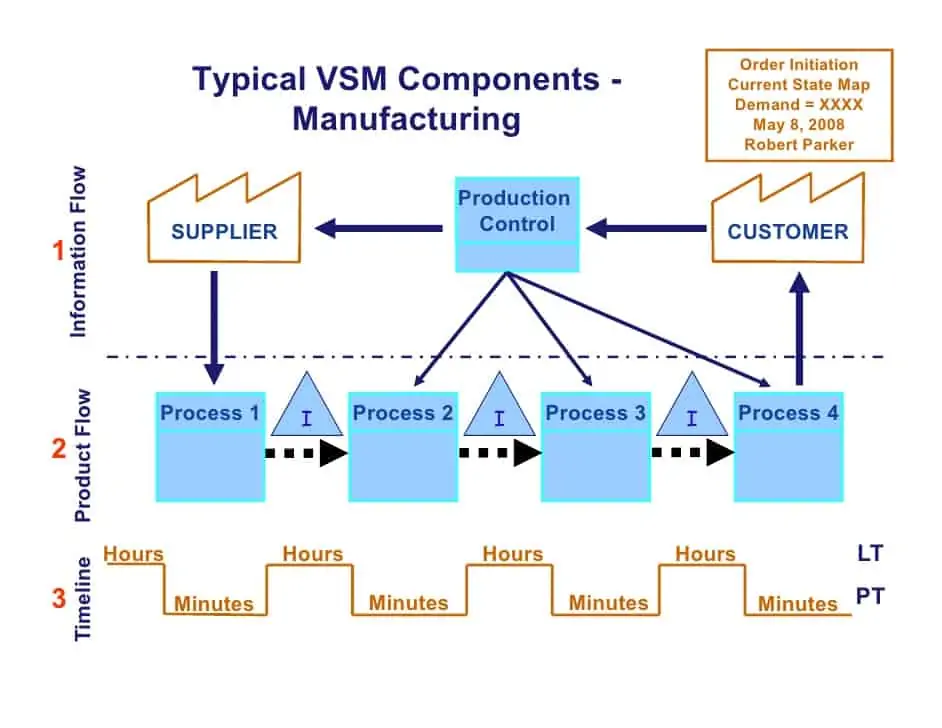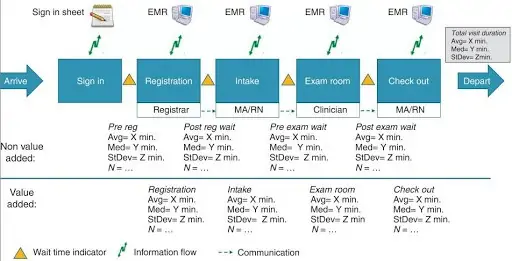In many industries, value stream mapping is a useful tool for visualizing the process it takes to deliver a product or service.
In fact, the practice of value stream mapping is so valuable to organizational efficiency that it can be traced all the way back to 1918.
If you’re a novice to creating a value stream map, we’re here to help.
Let’s discuss what value stream mapping is before we dive into the examples.
Definition of Value Stream Mapping
Value stream mapping is a flowchart that depicts the flow of inventory and information from the initial steps of a company’s process all the way to customer delivery.
It’s a vital aspect of lean manufacturing and is designed to identify waste and streamline operations processes by analyzing, designing, and managing the flow of materials and information through an organization.
Current State Maps versus Future State Maps
There are two types of value stream maps: Current State Maps and Future State Maps.
Current State Maps present what the actual process looks like for any operation, beginning to end. With this type of value stream map, you can identify weaknesses or points of waste to create an improved version of operations.
So the Future State Map is the improved (and idealized) version of your current state. Once those changes are implemented, the Future State Map becomes the Current State Map, freeing you up to improve the process even more with a new future state map.
A Criticism of Six Sigma’s Approach
Read the 4 Big Disadvantages of Lean Manufacturing
Value Stream Mapping Examples by Industry

Value Stream Map for Manufacturing
Since it was popularized by Toyota’s 1993 “Toyota Production System” book, manufacturing firms of all types and sizes have been using Value Stream Mapping to identify their inefficiencies.
By detailing every step of the manufacturing process, right from the supplier and through to the customer, manufacturers can identify bottlenecks and processes that can be improved – increasing overall efficiency and output.
(Source: NCBI)
Value Stream Map for Healthcare
Healthcare organizations are constantly faced with challenges around lead time and costs. After all, wait times are critical to patient satisfaction, and any delays in a process can lead to catastrophic results.
Increasing cost-effectiveness is paramount for hospital administrators.
Consider that surgeries account for 48% of all hospital revenue. A value stream map can be created to find inefficiencies in for each type of operation.
With an effective value stream map, hospitals and clinics can identify any bottlenecks that arise from the moment a patient enters the institution to when that patient leaves.

Value Stream Map for Finance
Leading financial firms are finding ways to reduce waste and leverage new technology practices to increase efficiency and ultimately drive the business.
By mapping out a financial institution’s different value streams, you can identify the costs of each process, determine which areas are outperforming others, and where unnecessary costs are allocated.
The true benefit rests in following up with these findings and matching high-cost, repetitive tasks to automation technology. According to PwC, the top financial firms have automated more than twice the number of key controls than that of your average firm.
Read More About Operational Efficiency and Lean Manufacturing:
- 12 Disastrous Operational Issues That Will Cost Your Business Millions
- 4 Big Disadvantages of Lean Manufacturing — A Criticism of Six Sigma’s Approach
- Alphabot: a Case Study in Use of Simulation for Product Feasibility Analysis

Value Stream Map for Offices
Offices can use value stream mapping to improve overall business performance.
The reality is, many offices (whether it be a small business or 10,000 seat enterprise) are bogged down by inefficient processes – be it interdepartmental communication issues, onboarding bottlenecks, and office supply inefficiencies.
And if any of these processes fail, the impact on employee productivity can be catastrophic.
For example, if an entire department loses access to a software necessary for day-to-day work, projects fall behind as IT scrambles to fix it.
With value stream mapping, businesses can identify the processes that cause issues most often and work to remedy them. It allows businesses to find all the processes that could be improved — or even removed entirely — by adopting new technology.
For nearly a decade, MOSIMTEC has provided solutions to complex operational issues. We understand that it can be difficult to gain the insights you need to improve your business operations. Contact us today to learn how we can provide the tools you need to achieve complete operational visibility and improve your processes.
Avoid Impeding Processes and Improve Operations with Expert Simulation and Predictive Modeling
